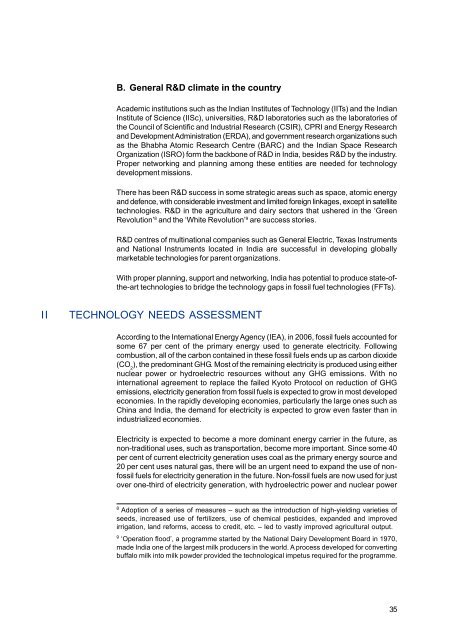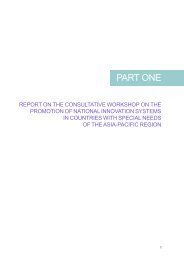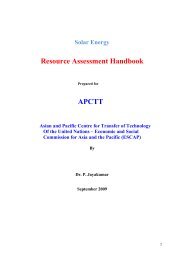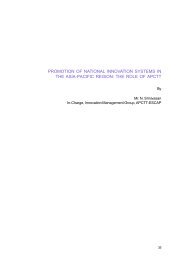Download Complete PDF - apctt
Download Complete PDF - apctt
Download Complete PDF - apctt
- No tags were found...
You also want an ePaper? Increase the reach of your titles
YUMPU automatically turns print PDFs into web optimized ePapers that Google loves.
B. General R&D climate in the countryAcademic institutions such as the Indian Institutes of Technology (IITs) and the IndianInstitute of Science (IISc), universities, R&D laboratories such as the laboratories ofthe Council of Scientific and Industrial Research (CSIR), CPRI and Energy Researchand Development Administration (ERDA), and government research organizations suchas the Bhabha Atomic Research Centre (BARC) and the Indian Space ResearchOrganization (ISRO) form the backbone of R&D in India, besides R&D by the industry.Proper networking and planning among these entities are needed for technologydevelopment missions.There has been R&D success in some strategic areas such as space, atomic energyand defence, with considerable investment and limited foreign linkages, except in satellitetechnologies. R&D in the agriculture and dairy sectors that ushered in the ‘GreenRevolution’ 8 and the ‘White Revolution’ 9 are success stories.R&D centres of multinational companies such as General Electric, Texas Instrumentsand National Instruments located in India are successful in developing globallymarketable technologies for parent organizations.With proper planning, support and networking, India has potential to produce state-ofthe-arttechnologies to bridge the technology gaps in fossil fuel technologies (FFTs).IITECHNOLOGY NEEDS ASSESSMENTAccording to the International Energy Agency (IEA), in 2006, fossil fuels accounted forsome 67 per cent of the primary energy used to generate electricity. Followingcombustion, all of the carbon contained in these fossil fuels ends up as carbon dioxide(CO 2), the predominant GHG. Most of the remaining electricity is produced using eithernuclear power or hydroelectric resources without any GHG emissions. With nointernational agreement to replace the failed Kyoto Protocol on reduction of GHGemissions, electricity generation from fossil fuels is expected to grow in most developedeconomies. In the rapidly developing economies, particularly the large ones such asChina and India, the demand for electricity is expected to grow even faster than inindustrialized economies.Electricity is expected to become a more dominant energy carrier in the future, asnon-traditional uses, such as transportation, become more important. Since some 40per cent of current electricity generation uses coal as the primary energy source and20 per cent uses natural gas, there will be an urgent need to expand the use of nonfossilfuels for electricity generation in the future. Non-fossil fuels are now used for justover one-third of electricity generation, with hydroelectric power and nuclear power8Adoption of a series of measures – such as the introduction of high-yielding varieties ofseeds, increased use of fertilizers, use of chemical pesticides, expanded and improvedirrigation, land reforms, access to credit, etc. – led to vastly improved agricultural output.9‘Operation flood’, a programme started by the National Dairy Development Board in 1970,made India one of the largest milk producers in the world. A process developed for convertingbuffalo milk into milk powder provided the technological impetus required for the programme.35







